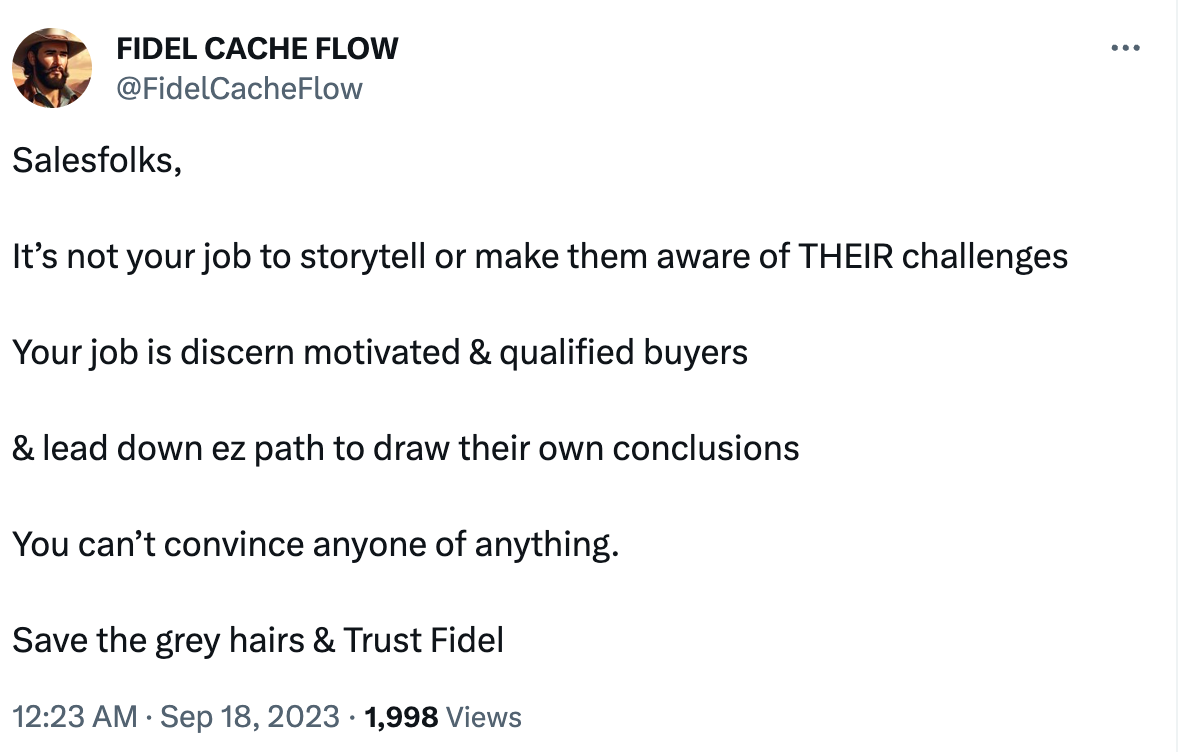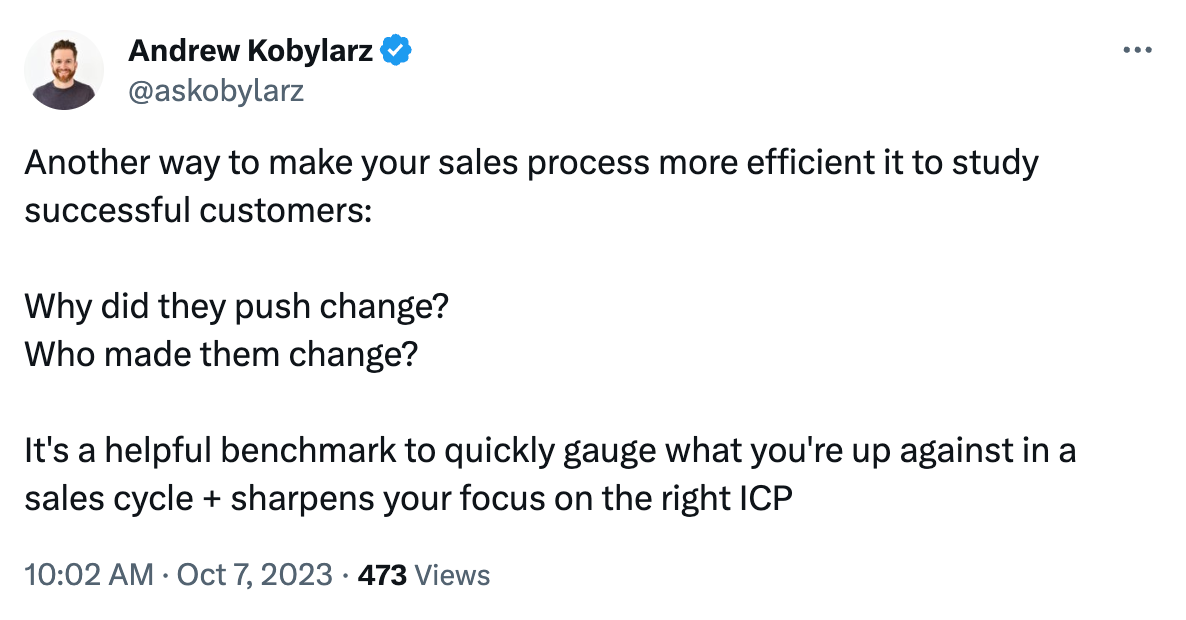The Ultimate Deal on ICPs
Make your sales process more efficient by refining your ICP
PS: I’ll be hosting a live session today at 7pm et/6pm cdt walking through how to break down account mapping. You can join Fidel’s cohort by clicking this link.
Sales culture is flawed in the sense that there’s a need to “convince” people to buy our product. That’s not the nature of what makes a successful seller today or in the future.
Beauty of SaaS covers this topic nicely in Death of the Average Salesman. It’s a great resource on painting the picture of what to focus on as a seller in this climate.
Under every “no” there’s a “yes”. I won’t disagree.
“No” is just the beginning of the conversation. But the conversation won’t always end in a purchase. It’s important to not just have your core ICP identified but understand your high value ICP’s and what were the characteristics that make them.
I recently was speaking with my manager about the frameworks of how we had gotten certain logos in our portfolio to multi million dollar deals.
I had questions like:
Who were the personas involved?
What was the challenge that they needed to overcome?
How did we get a groundswell of adoption?
Asking these questions could shed light on key milestones that would allow me to flag what was a potential high value account.
His response:
“THEY had actually come to US.”
I was FLOORED.
It made me start studying my ICP further to better understand the characteristics of an organization that would be “ones that would come to us”. This would also fit into the bucket of a suitable prospect for me to achieve a multi million dollar deal.
Today I’m going to cover three aspects that are critical in identifying where you can give yourself permission to double down on efforts within an account to inflate the average deal size. I’ve been using these frameworks in my role currently to start doubling down where I should be focusing my time for higher contract values.
It also adds another layer of qualification to know that I just don’t have a “deal”, but the ingredients for a larger deal.
These are in exact order:
Timing
People
Business Challenge
The actual substance of each bucket may vary depending on what you’re selling, but all in all, it’s a framework that you can apply. The end goal being how to leverage these characteristics of your target ICP to just about any role and streamline your sales process towards higher leverage and efficiency.
Timing
I recently had a call with a large financial institution. We had the right players on a call to be able to show how we can help with a highly publicized company initiative. Despite the fact that our offering could help and that this initiative was being driven by their CMO, I learned they didn’t currently have processes in place where our solution could help.
After two calls, I’m okay walking away on this one. They’re too early in their lifecycle.
You can’t turn an oil tanker in the middle of the ocean on a dime. I’m missing critical elements to help get a deal, let alone a transformational one. The first being internal buy-in. My job as a sales person isn’t to convince them they should be doing this, someone internally needs to be the change agent.
The amount of effort to get a prospect to a place of buy-in and agreement that they should have certain processes in place is a time horizon that’s better suited for marketing or nurturing. When they decide they should be doing what our product can help with, THAT’S when I can start guiding them into how to execute that with our product.
Key questions to ask yourself:
Where are they in the lifecycle of where you product can help? If they are using competitors that’s a good sign.
What are the signals that show that your ICP is there? Resources here.
Timing is the most critical element of any deal and you need to understand where your high value ICP’s are in the product lifecycle in order to know that you have the ingredients to push for a higher contract value.
Which leads to another critical piece in better understanding your ICP’s: The people.
People
In his book, Mega Deal Secrets, Jamal Reimer talks about how you need to have a “C-level insight” and a “core imperative” in place in order to have the makings of a mega deal.
He lists core imperative first, however I think that the “who” is much more important than the “what”. I’ve found that organizations make decisions in one of two ways:
They are following and aligned with a “vision” or North Star if you will (this is typically set by a senior executive
They are being educated by a change agent in how to do something differently that has buy in by senior level executives
Outside of timing, people are the most important element in any deal. It’s not a groundbreaking realization, I know. However I’m stressing the importance because if I don’t have senior level buy-in in saying that the organization should be changing, it’s a massive uphill battle to get support to make the change in the first place. Even if there is a business challenge.
The only caveat to this is an event that is catastrophic to a business, ie cybersecurity attack, supply chain delays, backlash against a brand campaign. Something that will cost them a lot of money if they don’t solve it FAST. Even still, this will naturally fall into one of the two buckets above.
You can’t convince executives, line managers, or people to change. Even if I could, trust is hard won because I’m in sales and have a bias towards the decision of change being suggested. They need to come to that conclusion themself.
Key Questions to Ask Yourself:
Who is driving for change and why?
Who has had the experience of driving that change if yes? Who is the change agent?
More resources on signals (ie usergems, LinkedIn Sales Navigator) in this link here.
Business Challenges
This is probably the most straightforward aspect. If you have carved out what typical challenges your customers have, it’ll be *easier* to qualify further and make suggestions on how to change.
If you have the other two in place, there’s a good chance there is a business challenge that needs to be solved, a “core imperative” if you will. This is where the selling happens.
At this stage you can make suggestions on how to change if you’ve earned that trust. I’ve written about how to earn trust here. Note that I’m not just qualifying, I’m also making suggestions.
Here are things I currently do to establish trust and GUIDE prospects to a solution:
Share stories of other customers and even facilitate introductions to those customers
Observations on this:
I’m not even sharing successes sometimes. It helps someone know you’ve been through this before. There’s immediate comfort in been there and done that. If not me, I have the resources and infrastructure in place to share perspectives.
(I OFFER case studies but I don’t talk through them or use them as my stories. I’m just being a human and telling them what I actually heard/see - say it in your own words.)
Ask questions about what they’re embarking on via consistent trends you keep hearing across the market.
Observations on this:
Don’t say or tell, ASK if they’ve been hearing the same thing. This will help you understand critical information and once again establishes comfort in what you’re seeing in the market.
On the topic of questions, BowTiedDingo recently posted, “Mastering Questioning Techniques for Enterprise Sales Success”. It’s a great resource for breaking down questioning frameworks.
Hopefully this helps you streamline more of your sales process and where you can identify opportunities fr higher leverage deals. I’ve been finding that it’s been helpful for me to identify ICP’s that I should double down my time and efforts on. It also gives me a quick benchmark of sales cycle timelines measuring against what I’ve done before or have seen play out based on other customers that fit this mold.
If you’re an earlier stage company, you can check out my free course on account mapping.
If you have any questions, hit me up at andrew@hackingsales.xyz or feel free to book some time to chat.
Thanks again for reading and see you next week.
-Andrew K



